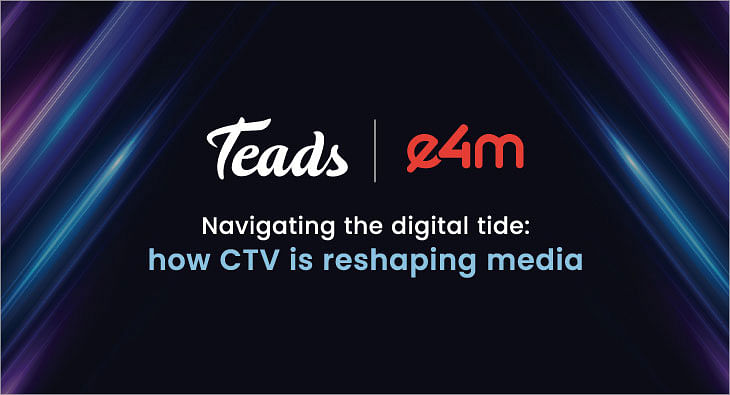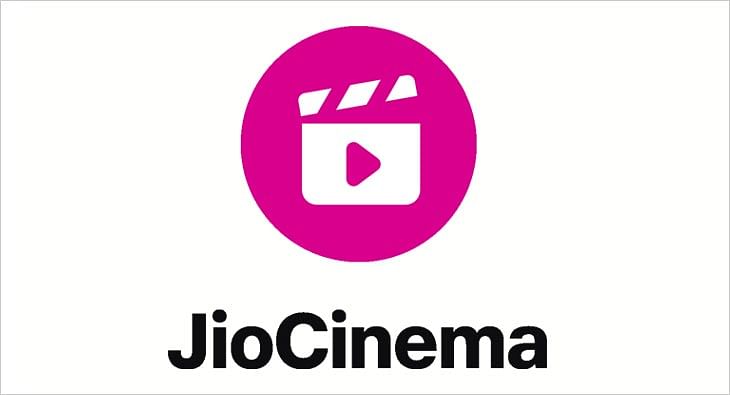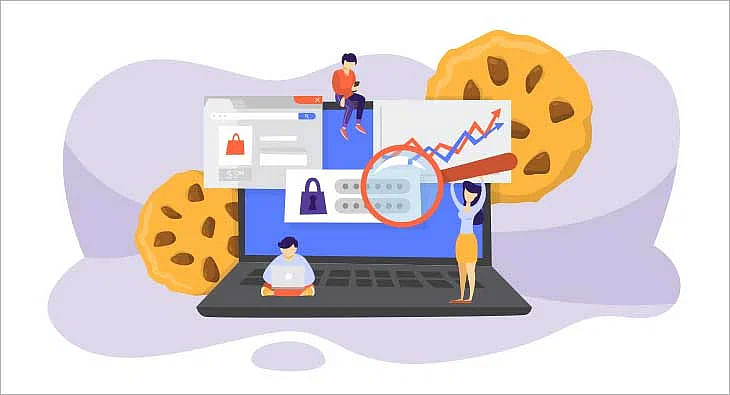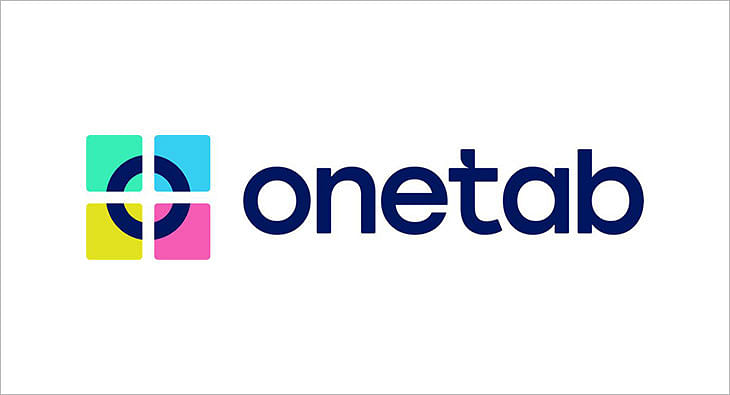Voiro provides revenue analytics to media companies that drive maximum ROI: Kavita Shenoy
Shenoy, Founder and CEO, Voiro, spoke about the trends in the OTT market and the role of technology in driving business growth

Bangalore-based SaaS start-up Voiro provides revenue optimization and workflow automation for content and media-led companies. Its product harnesses the power of data to track ad inventory in real-time. This enables ad-led companies, especially OTT platforms, to get actionable insights and make data-driven business decisions.
Voiro currently powers some of the biggest OTT players, digital publishers, and media houses in India such as Disney+ Hotstar, Voot, BookMyShow, Zee5, OLX, Flipkart, and DSTV (South Africa). In an interaction with exchange4media, Kavita Shenoy, Founder and CEO, Voiro spoke about the trends in the OTT market and the role of technology in driving business growth.
How is 2021 looking for the OTT industry in terms of business?
The COVID-19 pandemic has been a great accelerator for the Indian SVOD market with OTT video subscriptions reaching almost 62 million at the end of 2020, doubling from 32 million at the end of 2019. Growing affluence, an explosion in smart devices, and easy internet access have been key factors driving this growth. At the same time, initiatives by OTT players to offer exclusive and high-quality differentiated original content, coupled with programming for regional content has also driven growth. One of the most important things that we see on the rise in most OTT platforms is the diversity of content. For instance, people watched Narcos in Spanish with subtitles, and Amazon Prime released Dana Shows. The adoption of regional content is no more restricted to certain demographics. With the democratization of internet access, and easy access to smartphones, rural India is poised to lead the way to the next wave of OTT adopters.
Pricing strategies by the OTT platforms have also become much more flexible and whether it is their ad inventory, or even their subscription in inventory, they're trying to base it on the database. They're moving forward to actually addressing what consumers want today in terms of how they want to consume their content. Post 2021, the OTT industry might be a dose of entertainment with different kinds of technological experiences. With the rise of the gaming industry, both these factors might soon be seen on the same side of a coin offering people AI and VR viewing experiences on OTT platforms.
What kind of work is Voiro doing with OTT platforms?
Leading publishers have proprietary tools to analyze & mine data inhouse. The monetisation of advertising dollars and ROI on content is always a challenge and the publishers who thrive are those who find ways to make every ad dollar count. Voiro provides revenue analytics to media companies that drive maximum ROI, whether through direct ad sales or indirect automated sales channels such as programmatic partners. We have a strong API strategy that allows integration into multiple tech stacks and our customers have one revenue horizon.
Voiro's intelligent reconciliation module lets publishers be 100% confident of their revenue at any given time. We read several leading indicators from direct as well as indirect sales channels and reconcile revenue in real time across multiple touch-points, while the algorithms behind our engine account for campaign events, currency conversions, custom buyer requests for amortization as well as third party or custom metrics that drive actual billing. As a result, we are able to project the most accurate revenue across every single dashboard, report and touch-point.
At the end of the billing cycle, the revenue is already reconciled, helping the finance team of the publishers to cut short their billing cycles from a week to 1-2 hours. Finally, Voiro connects downstream ERP and billing systems, giving a truly complete solution and bringing robustness to a complicated billing cycle.
Tell us about Voiro's cloud based solutions, and how are OTT platforms using them to streamline their business?
We’re India’s first all-in-one revenue management suite exclusively for ad-led digital publishers across media. Our cloud-based solution is built to tackle the complex world of multiple revenue channels and provides the best data security and protection, critical for a data-driven, content-centric industry. With our finger on the pulse of India’s digital media landscape, we’ve grown our revenue suite with the country’s leading OTT brands — and they’ve grown their revenue streams with us!
Most businesses today are publicly listed companies and they have a good grip on their revenue level information, but they struggle to have systems in place that can take into account all of their revenue streams. Also, they need to ensure their quarter results are compliant with the law of the land. We give teams the flexibility to experiment with several revenue streams, several technology partners, so that they're able to make decisions based on what's working for them. OTT platforms have the razor-sharp focus of being able to focus on what they do best - focus on content, with partners like Voiro supporting them with the technology needed to drive better business decisions.
How important is ad tech in driving ad revenue growth for publishers?
Publishers can make revenue in n-number of ways. Either one pays for the content or watches it free through an ad subsidised model.
Imagine if - as concurrency went through the roof, as we watched the most prized piece of internet real estate unfurl and create itself in front of our eyes, we had the capability to hit a button that said \"more!\" or \"now!\" and that triggered an automated cycle that's safe, secure and optimizes pricing in real time. Given our automation and ops workflows, everything else is already taken care of by our systems that are working beautifully in sync. Approvals, creative QC, pre-loaded key values and targeting tags and campaign runs - leaving a few, select buyers with the ability to capitalize on a spot where the entire planet is focussing their attention, but only for a split second. And that split second needs to count, because monetising inventory for live events is being able to make a split second decision. Matches can be rained out, CDN’s can crash and ads can fail to reach the viewer. For an effortless approach to revenue monetisation and ensuring that the ad revenue is optimised within an uncertain environment like a live sporting event or an ecommerce flash sale!
In the world of ad monetisation - imagine if you could trigger an automated cycle that's safe, secure, and could optimise pricing in real-time? From automation to ops workflows, everything is taken care of by our systems that work beautifully in sync. At Voiro, we ensure that India’s top publishers and media companies can have their choice of technology at any given time without ever having to grapple for business intelligence or lose monetising ad inventory.
Consumers have a short attention span on digital. How can OTT platforms keep up with the changing consumer preferences for content?
Today, consumers are exposed to a lot of content and choices online. Earlier, consumers would only watch one particular type of genre but today, there is no loyalty in terms of genre. People are just skimming through content on their gadgets and moving from one kind of content to the other; and this is how the future seems like as well because everyone is spoiled for choice.
To keep up with the changing consumer preferences for content, it is necessary to understand what the audience wants. It is necessary to provide different genres of content in different languages. Multilingual content too opens up a door to new audiences, it eliminates the language barrier because of the ability of technology to transcribe and translate fast and contextually as well. It also opens up cross-cultural sharing.
As humans, we crave new experiences. So offering consumers personalized experiences on OTT platforms can be a bait to attract a larger audience base. It can be in the form of live streaming or shopping options as many brands are seen jumping to the bandwagon of live streaming setting. It can be gaming content or AR and VR based content. The key is to serve the audience what they desire, at the time they desire in, in the languages they desire and constantly create novel viewing experiences.
How can OTT platforms leverage first-party data in enhancing their offering for viewers as well as advertisers?
Cookies kind of walked themselves to the grave and then came walking back with Google’s Privacy Sandbox & FLoC. Creating data moats and using the historical value of first party data is key to a publisher’s ability to monetise content and build the right audiences in line with their brand strategy.
First-party data can provide great insights to advertisers and target audiences and enable the crafting of a tailored ad sales strategy based on audience intelligence. When first-data is properly analyzed and evaluated, the media owners can reach across all distribution channels and it allows the advertisers to target the right audience and find new audiences, irrespective of where they are consuming the content. First-party data strategy creates relevance and prevents the audience from being served inappropriate ads and irrelevant content.
As advertising on OTT platforms sees a sharp increase, what are some of the challenges that brands face in achieving their marketing and business goals?
One is the cloud. It's always going to be there, the ability, the need to differentiate themselves with the amount of content that is available online. The second is provable success. That is something that a lot of brands struggle with because they need to understand whether the campaign they execute with the publisher or within a particular time period, actually works for them to be able to repeat that success or reinvent the process. Third is the regulatory landscape - in terms of understanding the law of the land. The fourth one is innovation - beyond a particular point a publisher needs to recalculate innovation and on top of that transparency, repeatability of success and facing a failure needs to be evaluated.
Each OTT platform is competing neck to neck with each other on content, the differentiation of content, the type of tentpole events, the innovation and definitely the creativity that brands need to make them memorable. If they are able to stay afloat in this, they are bound to move a step closer to achieving their business goals.
What steps should OTT platforms take to grow their advertising business?
The steps that OTT platforms should take to grow their businesses is to make sure that they're opening up many more monetization streams. Subscription and advertising revenue will always be like the cola wars and this is an undeniable fact as the churn experienced by OTT players after a flagship event is a key reason to have ad revenue bolster subscription. We have seen large players launch ad monetisation a few years after the launch of subscription, as the industry needs every possible channel to grow revenue.
Large publishers can definitely jump onto the bandwagon of publisher commerce because of the ease of buying today - The fact that you can transact easily is great. With the increased ease of transaction, the friction has gone away. Also, viewers are becoming device agnostic. Hence, the OTT platforms can start looking at creating or owning content distribution and bridge the device divides. I think that is definitely a big avenue over there in conjunction to understanding your audiences. And most importantly none of this is about advertising to everyone. It's about intelligently converting and placing things that you believe a particular audience will appreciate.
Delivering the right ads to the right audience has become the prerequisite for brands. Are the OTT platforms rising to this challenge?
Earlier, targeting was based on the data pulled from the header information of a browser but today, it is based on interests, demographics, devices and much more. It is evident that ad tech has become more intricately detailed. The rapid and exponential development of the ad-tech space has pushed publishers and advertisers to constantly search for improved solutions on how best to ensure their content reaches the right person at the right time. OTT platforms are taking to automated solutions to keep a track of this. The existing user and content data helps the platform to generate near-accurate forecasts in regards to targeting the potential audience for ad-sales.
With the help of intelligent real-time data solutions, brands are able to deliver the right ad to the right audience at the right time in the right format and at the right place. However, it is a challenge to keep with the upcoming trends of immersive narratives and voice search. that are affecting the world of digital advertising. Ads have to be in sync with the brand and narrative, and also with the entire wave of audio and voice-based search, publishers need to start serving non-intrusive, user-friendly ads. Great examples of brands that have successfully created data moats are Spotify, E-Commerce giants and the brands that used safety as a hook during the pandemic.
Read more news about Digital Media, Internet Advertising, Marketing News, Television Media, Radio Media
For more updates, be socially connected with us onInstagram, LinkedIn, Twitter, Facebook, Youtube, Whatsapp & Google News
Meta posts 27% jump in Q1 revenue
Meta’s advertising revenue for the quarter stood at $35,635 million as compared to $28,101 million the same quarter last year
Meta Platforms has reported financial results for the quarter ended March 31, 2024.
The platform has posted total revenue of $36.46 billion, a 27% increase from last year.
The advertising revenue for the quarter ended March 31 stood at $35,635 million as compared to $28,101 million the same quarter last year.
Ad impressions delivered across Meta’s family of apps have increased by 20% year-over-year, the tech giant said. The average price per ad has also increased by 6% year-over-year.
Total costs and expenses stands at $22.64 billion, an increase of 6% year-over-year, while capital expenditures, including principal payments on finance leases, were $6.72 billion.
"It's been a good start to the year," said Mark Zuckerberg, Meta founder and CEO. "The new version of Meta AI with Llama 3 is another step towards building the world's leading AI. We're seeing healthy growth across our apps and we continue making steady progress building the metaverse as well.”
Cookie still here: Where are marketers headed?
Delay of cookie phase-out isn't just a postponement, but a wake-up call. It underscores need for an ecosystem that prioritises user privacy while delivering effective advertising, say experts
While the ‘what’ of Google delaying cookie deprecation has been largely addressed by now, it is about time to bring up who stands to get most affected out of the many players in this game. For instance, since the cookie deprecation announcement first happened in 2020, publishers, vendors and advertisers are all geared up to ace their first-party data game. Heavy investments went into building first party data stacks and tools.
Advertisers (even legacy brands) shifted their businesses largely to D2C channels in order to get first-party consumer data. exchange4media had previously reported how FMCG led the investments, as ‘cookie crumble’ picked pace earlier this year. Rajiv Dingra, Founder & CEO of ReBid, had shared that the agency had been approached by FMCG players for a plan to collect approximately 30 million first-party data in the next two years. “They are willing to spend for the same,” he had added.
Cut to April 2024
Given the immense numbers of stakeholders involved, from Google to publishers to advertisers to the users themselves (whom these changes are actually meant for), there is clearly a need to appeal to the biggest kid on the playground. And above Google are only policymakers, (sorry gods).
According to a digital expert’s LinkedIn post (following the delay announcement), the number of startups that launched alternative solutions to capture and carry consent in an independent manner since 2019 have all burned their cash and have either been shut down or bought over by legacy companies.
Furthermore, noting that the US, EU, and Australia are the biggest arbiters of industry practices in their (and the larger world's) geographies, Preetham Venkky, CDO at DDB Mudra says, for Google, it's all about getting that consensus.
“This move to PSB (Privacy Sandbox) isn't just one step ahead of third-party cookies; it's about 10 steps ahead. It's only natural then for Google to seek the broadest possible consensus for these changes that they are looking to implement. Once these particular policymakers express their satisfaction with and ratify the PSB practices that Google looks to bring about, the company will feel much more confident about rolling them out globally.”
What happened
The so-called ‘demise’ of third-party cookies hits the different segments of the digital advertising landscape, in very different ways. Russhabh R Thakkar, Founder and CEO of Frodoh World agrees.
According to him, the demise of third-party cookies threw a wrench into the well-oiled machine of digital advertising. “While everyone felt the pinch, the pain points differed,” he says.
Experts say that for publishers, the challenge still lies in transitioning from a third-party data crutch to a first-party data cane.
Thakkar adds that building robust in-house data collection requires investment and strategic planning, but ultimately fosters a deeper understanding of their audience and potentially higher ad value in the long run. “CTV platforms, for example, had a headstart here, as they often collect valuable viewing data that can be leveraged for more effective ad targeting.”
Vendors, on the other hand, faced and are still facing a more fundamental shift. Their entire ad-tech infrastructure was built on cookies. Now, they're scrambling to develop and gain industry-wide adoption for entirely new solutions like contextual targeting and privacy-preserving identity models.
“Advertisers, used to the laser focus of cookie-based targeting, now grapple with broader contextual targeting and a more probabilistic approach to campaign measurement. However, this can be an opportunity to invest in building direct relationships with publishers, fostering long-term brand loyalty,” Thakkar further explained.
Beyond Borders
For Venkky, it's now about bringing about change at international policy level, in order to bring about change to your desktop browsing.
“The delay isn't just a postponement; it's a wake-up call. It underscores the need for a future-proof ecosystem that prioritises user privacy while delivering effective advertising. The most adaptable players, those who cannot only weather the short-term disruption but also leverage this as a catalyst for innovation, will be the ones who thrive in the post-cookie era,” says Thakkar.
A digital expert from a leading agency shared on his LinkedIn post, “The cookie-less future isn't the whole story, it's just one part of where we're headed in a privacy-first world. Effective advertising is powered by a wide variety of signals, not just cookies.”
An industry source had told exchange4media earlier that some tests that were run in Europe for Privacy Sandbox, didn’t yield very favourable outcomes. “The campaigns that were run using Privacy Sandbox APIs had lower click through rates and the conversion rate per dollar were one to three percent lesser for the test group, as compared to if they did the same thing using third party cookies,” the source had added.
Back to the future?
As of 4th January 2024, Chrome had started restricting third-party cookies by default for 1% of Chrome browsers. “It may take several days to reach the full 1%,” Google had noted in its announcement. It is the end of April and according to experts, it still hasn’t reached that 1% mark.
All of these facts beg one question – how serious is the hype around third-party cookie deprecation? We’ll hold that thought for now.
Industry will get time to adapt to cookie deprecation: Experts on phase-out delay
Industry players say the delay will give Google more time to address concerns surrounding its proposed solutions
It wasn’t that much of a surprise, but the news that Google has (yet again) delayed the deprecation of third-party cookies is already doing the rounds in any business even vaguely related to digital media. The much-vaunted rollout of its Privacy Sandbox as a viable alternative to cookies has also been impacted in a move that had been long predicted by industry watchers, given the absence of an all-encompassing ecosystem to take the place of said cookies.
Gopa Menon, Head of Digital for South Asia at Mindshare, believes this gives the industry more time to adjust and allows Google to address concerns surrounding its proposed solutions. He identified several issues that still needed addressing, which this delay will now allow.
“The industry needs time as marketers and advertisers need time to adapt to new tracking methods, and privacy concerns. Proposed alternatives raise questions about user privacy and potential advantages for Google,” he said.
This is the third time that Google has pushed back the final crumble of the cookie, originally scheduled for 2020. The pandemic didn’t help, but since then, nor has the lack of a fully viable alternative to the ubiquity of the cookie, so precious to advertisers and marketers.
In a blog post on Privacy Sandbox, Google wrote, “We recognize that there are ongoing challenges related to reconciling divergent feedback from the industry, regulators and developers, and will continue to engage closely with the entire ecosystem. It's also critical that the CMA has sufficient time to review all evidence including results from industry tests, which the CMA has asked market participants to provide by the end of June. Given both of these significant considerations, we will not complete third-party cookie deprecation during the second half of Q4.”
Sajal Gupta, Chief Executive for Kiaos Marketing Pvt Ltd, also points out that UK’s competition controller, Competition and Markets Authority (CMA) made some observations on the tests on Google’s cookie-less solution called Privacy Sandbox. This move comes even as Google is set to declare its earnings for the previous quarter.
While Google may continue to benefit from user activity data while limiting competitors’ access to the same data, Google’s ability to control the inclusion of ad tech rivals on this list could advantage its ad tech services. Publishers and advertisers may be less able to effectively identify fraudulent activity.
According to Gupta, “More intensive work needs to go in by the team in Google to solve CMA’s concerns. The regulators got involved when there were observations of user privacy being compromised, this is getting addressed partially and gaps remain. Publishers and advertisers are concerned about measurement which will be broken in the cookie-less world, platforms and AdTech players have a roadmap yet.”
Agreeing that the development was unsurprising, Abhinay Bhasin, Head of Product Marketing for Profitwheel, added, “The main roadblocks I’d assume is reconciling feedback from the multiple stakeholders involved and keeping in line with the overall vision of the endeavour - to safeguard consumer privacy.”
Meanwhile, never one to lose hope, Google added in its statement, “We remain committed to engaging closely with the CMA and ICO and we hope to conclude that process this year. Assuming we can reach an agreement, we envision proceeding with third-party cookie deprecation starting early next year.”
Google delays cookie phase-out again
'We will not complete third-party cookie deprecation during the second half of Q4,' said the tech giant in a blog post on Tuesday
Tech giant Google has announced that there will be a delay in phasing out third-party cookies. "We are providing an update on the plan for third-party cookie deprecation on Chrome," said Google in a post on Privacy Sandbox News.
The announcement was made on Tuesday, April 23, ahead of the quarterly reports from Google and the UK's Competition and Markets Authority (CMA).
Google cited challenges in the ad market in the absence of cookies and CMA's need for time to review results from industry tests as the reasons for the delay.
"We recognize that there are ongoing challenges related to reconciling divergent feedback from the industry, regulators and developers, and will continue to engage closely with the entire ecosystem.
"It's also critical that the CMA has sufficient time to review all evidence including results from industry tests, which the CMA has asked market participants to provide by the end of June. Given both of these significant considerations, we will not complete third-party cookie deprecation during the second half of Q4," it said.
The tech giant also upheld its commitment to engaging closely with the CMA and ICO and closing the process this year. Google also said that it envisions proceeding with the cookie deprecation starting early next year.
This is the third time that Google has delayed third-party cookie deprecation. The original deadline for the phase-out was January 2020.
Google repeatedly stated its intention to phase out cookies in Chrome by the end of 2024 and was actively developing alternative solutions like Privacy Sandbox to provide for targeted advertising and audience measurement.
Google had previously committed to a firm timeline in 2023 with a phased approach supposed to start with 1% deprecation in January 2024 gradually increasing until eliminating 100% of third-party cookies in the second half of 2024.
Virtual Influencers: Advertisers’ dream or creators’ nightmare?
Experts say there’s plenty of space to grow and they see VIs and real influencers coexisting and complementing each other in the future
From having entered the advertiser’s lexicon as a buzz word a couple of years ago, influencer marketing is increasingly becoming a big-ticket item on a brand’s ad spend plans. According to the latest 'State of influencer marketing in India' report by EY, influencer marketing is set to surge by 25% in 2024, reaching Rs 2,344 crore and projected to hit Rs 3,375 crore by 2026.
As Generation Z and Generation Alpha come to the forefront and change consumption patterns and habits, and look beyond the limelight traditionally hogged by celebrities like actors, athletes, and musicians, this cavalcade of content creators are challenging the status quo, and commanding the same kind of paychecks. But, like with everyone else, even their jobs aren’t immune, thanks, naturally, to AI.
Lil Miquela, a virtual influencer with over 3 million Instagram followers, has successfully partnered with major brands like Samsung and Calvin Klein. Her ability to connect with a younger demographic in a relatable yet aspirational way is a testament to the power of VIs.
Venugopal Ganganna, CEO, Langoor Digital, agrees that one trend that's captured his attention – and the attention of marketers worldwide – is the rise of virtual influencers (VIs). “These computer-generated personalities are not just a fad; they represent a significant shift in how brands connect with consumers.”
Advantage AI
The collaboration between virtual influencer Lil Miquela and BMW serves as a compelling indication that the trend towards virtual endorsements is gaining momentum
John Paite, chief creative officer, India, Media.Monks points out that virtual influencers could serve as lifelong brand ambassadors without the need for pay or discipline, offering brands remarkable efficiency across the board.
“While the initial setup and production costs can be steep, the long-term benefits promise significant returns on investment. As AI technology advances and tools for creating virtual influencers, digital avatars and AI characters improve, their development is expected to become quicker and simpler. Given these trends, it's likely that more brands will adopt this model in the coming years,” says Paite.
Indeed, a 2022 consumer survey by the Influencer Marketing Factory revealed that 58% of respondents follow at least one VI. Furthermore, 35% of consumers have purchased products recommended by VIs, demonstrating their potential to drive sales.
In India, boAt, Titan Eye & Realme have already collaborated with Indian virtual influencer Kyra. “While the flare of AI and the curiosity of the audience are primary reasons for the brands to adapt at this moment, there is potential for virtual influencer creation and management to grow into a market itself,” says Sajeesh Radhakrishnan, Revenue Director - SME & Startups, HiveMinds.
“For one of our QSR clients, 16-18 % of all digital (performance marketing) orders came through influencers. In another client from the insurance sector, we see a conversion of 1.6X higher for influencer-led ad assets. The ease of creating virtual assets will definitely boost brands to adapt virtual influencer strategy to every part of digital channels,” he adds.
Virtual vs Reality?
However, Karan Pherwani, Vice President, Chtrbox says that while it is convenient for brands to have an individual face of the brand in terms of availability and delivery of the brand message, it lacks the authenticity and credibility that the content creator brings to the table. “While AI influencers can flawlessly execute a brand's vision, fostering a genuine connection with the audience, which ultimately drives business growth, often relies on the creator's unique perspective and their leading execution for the brands.”
“What makes influencers desirable is their unique style, be it their regional accent, familiar setup or the topics they are passionate about. Almost all good influencers keep things real and add their signature to any brand message they deliver. They don’t use brand ad assets but co-create ad assets with brands. There is trust and familiarity between an influencer and their followers,” agrees Radhakrishnan.
And given the burgeoning of the influencer economy, experts agree that there’s plenty of space to grow, with brands going into a future happy in the knowledge that they have plenty of options, both real and virtual. And as alongside its real-life counterparts, AI technology continues to evolve, so will the capabilities of VIs, from VIs interacting with customers in real-time, to personalizing the shopping experience or offering product tutorials.
“Instead of a zero-sum game, I see VIs and real influencers coexisting and complementing each other. Brands can leverage VIs for targeted campaigns and precise messaging, while partnering with real influencers for broader brand awareness and a touch of human connection,” says Ganganna. Imagine a scenario where a VI spearheads a product launch, generating initial excitement, while a real influencer then reviews the product, offering an authentic user experience. This combined approach can be incredibly effective.
“In summary, virtual influencers are becoming popular because they're easy to manage and cost-effective. However, this trend also allows human influencers to stand out by highlighting their unique human traits. As the industry evolves, human and virtual influencers must find new ways to work together and enhance the overall marketing landscape,” says Paite.
Sociapa gets digital mandate for Tennishub
'Truly elated to join hands with Tennishub,' said Sociapa about its newly forged association
Sociapa has bagged the digital mandate for Tennishub, an online Tennis store.
Founder of Sociapa, Dheeraj Raj, expressed his profound excitement about the partnership with Tennishub, a pioneering name in the realm of online tennis stores. He said, "We are truly elated to join hands with Tennishub, a brand that exemplifies excellence in its field." He added, "The prospect of embarking on this journey with Tennishub fills me with immense happiness and optimism”.
In response to the announcement, Ronak Sachdeva, Founder, Tennishub said, “We are equally thrilled to partner with Sociapa, recognizing the agency's expertise and innovative strategies in the digital marketing landscape”.
Generative AI SaaS startup Onetab expands India operations
Onetab has appointed three senior team members
Onetab, the Generative AI SaaS startup, has appointed three new senior members to strengthen its India operations.
Harish Chouhan joins as Sr. Team Lead, Pratish Gopinath comes on board as VP – Corporate Development and Ankita Phanse joins as Head HR – Strategy & Planning of Onetab starting this financial year.
This team expansion comes as a step towards Onetab’s long-term growth strategy across India and global markets.
Harish Chouhan comes with over 17+ years of industry expertise which spans across multiple domains. He holds strong leadership acumen that motivates cross-functional teams to deliver high-quality results leveraging his familiarity with agile tools like Jira and Trello. Prior to Onetab, he was with Panamax Infotech, Linkites Pvt. Ltd, and InfoBeans Systems India Pvt Ltd. At Onetab he will be collaborating closely with the leadership team where he will contribute to strategic planning and execution along with fostering innovation, promoting excellence, and staying abreast of market trends and customer needs. He will play a key part in propelling Onetab toward its growth objectives and solidifying its position as an industry leader.
Pratish Gopinath will be based out of Bangalore where he will be spearheading the Bangalore office opening and hiring process. He will also look into identifying and executing strategic partnerships, investor and VC relations and hosting Onetab’s latest initiative One Bharat across multiple cities across India.
Ankita Phanse comes with over 7 years of comprehensive experience in and around the scope of HR operations and Generalist HR affairs. She holds an MBA with dual specialization in HR and Finance, and her key role at Onetab is to leverage her expertise to develop and implement HR policies/processes and programs fostering a positive work culture at OneTab.
Speaking on the new appointments Saket Dandotia, Founder, Onetab said, “I am excited for Onetab as we welcome Harish, Pratish and Ankita onboard. At Onetab we are currently on a growing spree, and we need a strong team with matches our long-term vision. With our new property, OneBharat, now activated and other activities in the pipeline, this step of hiring senior team members comes in sync with our future goals.”











 Share
Share







